| 31 May |
• yesterday • tomorrow |
| Feast of the Visitation of the Blessed Virgin Mary |
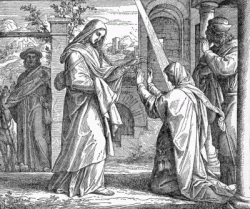
This day is called the Visitation of the Blessed Virgin Mary because on it Mary visited her cousin Elizabeth, whom, as the angel had told her, God had blessed with a son in her old age.
In the Introit of the Mass the Church sings
"Hail, holy parent, who didst bring forth the King Who rules heaven and earth forever. My heart hath uttered a good word; I speak of my works for the King."
Glory be to the Father, and to the Son, and to the Holy Ghost. As it was in the beginning, is now, and ever shall be, world without end. Amen.
Vouchsafe, O Lord, we beseech Thee, unto us Thy servants the gift of Thy heavenly grace, that, as in the childbirth of the Blessed Virgin our salvation began, so from the votive solemnity of her visitation we may obtain an increase of peace. Through Our Lord Jesus Christ, etc. Amen.
Behold he cometh leaping upon the mountains, skipping over the hills. My beloved is like a roe or a young hart; behold he standeth behind our wall, looking through the windows, looking through the lattices. Behold my beloved speaketh to me: Arise, make haste, my love, my dove, my beautiful one, and come. For winter is now past, the rain is over and gone. The flowers have appeared in our land, the tune of pruning is come; the voice of the turtle is heard in our land; the fig-tree hath put forth her green figs; the vines in flower yield their sweet smell. Arise, my love, my beautiful one, and come; my dove in the clifts of the rock, in the hollow places of the wall, show me thy face, let thy voice sound in my ears; for thy. voice is sweet, and thy face comely.
At that time: Mary rising up went unto the hill-country with haste, into a city of Juda; and she entered into the house of Zachary, and saluted Elizabeth. And it came to pass, that when Elizabeth heard the salutation of Mary, the infant leaped in her womb, and Elizabeth was filled with the Holy Ghost; and she cried out with a loud voice and said: Blessed art thou among women, and blessed is the fruit of thy womb. And whence is this to me, that the Mother of my Lord should come to me? For behold, as soon as the voice of thy salutation sounded in my ears, the infant in my womb leaped for joy. And blessed art thou that hast believed, because those things shall be accomplished that were spoken to thee by the Lord. And Mary said: My soul doth magnify the Lord; and my spirit hath rejoiced in God my Saviour.
As soon as Mary heard that Elizabeth was with child she hastened to her. The alacrity of the Blessed Virgin teaches us that we should take part with gladness in the happiness of our fellow-men, and quickly make ourselves ready to discharge our duties, sacrificing for that object, if necessary, even our own much-loved retirement, our devotions and other exercises of piety.
Mary visited her cousin out of real love, not out of unmeaning ceremony. Would that her example were followed in our visits!
By the visit of the Blessed Virgin John was sanctified in his mother's womb, and Elizabeth, enlightened by the Holy Ghost, knew, by the miraculous movements of her child, that Mary was the Mother of the Lord. Such effects did this visit produce. What would Jesus effect in us if we received Him with due preparation!
Explanation of the Canticle "Magnificat," Or "My Soul Doth Magnify The Lord"
In this hymn Mary with joy praises God, the Lord, that He has regarded her humility, aud made her to be the Mother of His only-begotten Son, wherefore she should be called blessed by all generations; and she declares the truths and mysteries which the incarnation brought to light. The mercy of God, namely, reaches from generation to generation to them that fear Him. He scatters the thoughts of the proud, and puts down from their seats the mighty; but He exalts the humble. He fills those who hunger for justice with good things, but those who think themselves rich He sends away empty. He receives all true Israelites, and performs in them the promises which He gave to the fathers. This hymn is repeated by the Church every day at Vespers, in praise of the work of redemption, begun by the incarnation of the Son of God in Mary. Would that every Christian, since he becomes one only by Christ being, as it were, born in him, might share those feelings which the Blessed Virgin and Mother has expressed in this hymn of praise, and, with the Church, daily praise God for the mystery of the incarnation!
O Lord Jesus Christ, Son of the living God, Who didst descend from the highest heavens io the womb of the Virgin Mary, didst therein rest for rune months, and with her didst condescend to visit and sanctify Saint John, grant that we, by the practice of good works, particularly of humility, may become partakers of the fruits of Thy incarnation.
https://catholicsaints.info/feast-of-the-visitation-of-the-blessed-virgin-mary/
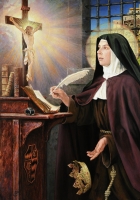
• Battista Varano
• Camilla da Varano
Born to the wealthy nobility; her father was the prince of Camerino, Italy. Camilla early felt a call to the religious life, which her family initially opposed, hoping for a good marriage for her. She became a Poor Clare nun in Urbino, Italy at age 23. Abbess of the convent of Santa Maria Nuova at Camarino, Italy which her father had restored for her. In 1502 her father and brothers were all killed for political reasons. In 1505, Pope Julius II sent her to found a Poor Clare convent in Fermo, Italy. In 1521 she helped institute the rule of the Poor Clares in San Severino Marche, Italy. Visionary; the visions of angels helped her understand several theological concepts. Stigmatist.
9 April 1458 in Camerino, Macerata, Italy
• 31 May 1524 in Camerino, Macerata, Italy of natural causes
• interred in the Poor Clare monastery in Camerino
• 7 April 1843 by Pope Gregory XVI (cultus confirmed)
• 19 December 2005 by Pope Benedict XVI (decree of heroic virtues)
17 October 2010 Pope Benedict XVI
• Praises of the Visions of Christ, 1479 - 1481
• Remembrances of Jesus, 1483
• Treatise on the Mental Sufferings of Jesus Christ our Lord, 1488
• The Spiritual Life, 1491
Two angels came to me, dressed in resplendent white garments which I have seen only worn by Jesus. They had wings of gold. One of them took my soul from the right side, the other from the left side, and they elevated it in the air, laying it down near the crucified feet of the Son of God made Man. This state lasted about two months almost continually; I seem to walk, to speak, and do what I wished, deprived however of my soul. It remained there where the two Angels had placed it but they never abandoned it. They (the celestial spirits) declare to me that they were so intimate with God that God is not ever separated from them. They also explained to me that the Seraphim were likewise united to the Cherubim in that none of them could ever go without the other to a soul. - from The Spiritual Life by Saint Camilla
https://catholicsaints.info/saint-camilla-battista-varano/
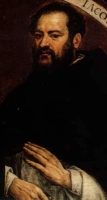
• Father of the Poor
• James of Salomonio
• James Salomonelli
• James Salomonio
• James Salomonius
• James the Venetian
Born to the nobility, and an only child. His father died when James was very small, his mother left the family to become a Cistercian nun, and James was raised by his grandmother. Tutored by a Cistercian monk who taught the boy to meditate. When he came of age, he became a Dominican at Santa Maria Celeste in Venice, Italy. On his way to the monastery he gave away his money to the poor he met on the way, keeping only enough to buy books; on arrival, he found a lay-brother in need of clothes; he gave the man the rest of his money, and entered empty-handed. Dominican for 66 years, holding offices in several houses in and around Venice. When word got out about his gift for spiritual direction, he feared the notoriety, and tried to withdraw from public life, transferring to the house in Forli, Italy, a place noted for its poverty and strict observance. Worked with the sick, heard confessions by the hour, and gave away everything that came to hand. Noted healer with hundreds of miraculous cures attributed to his intervention.
1231 at Venice, Italy
• 31 March 1314 of cancer at Forli, Italy
• buried in the chapel at Forli
1526 by Pope Clement VII
• against cancer; cancer patients
• Forli, Italy
• Dominican surrounded by a horde of petitioners
• Dominican with a staff and book and the Christ-child over his heart
• Dominican holding a heart with the letters "IHS" on it
God of endless ages, in your providence you gave your people Blessed James to attain the mystery of salvation. By his life and prayers may we come to know your Son and so experience his presence more fully in our lives. We ask this through our Lord Jesus Christ, your Son, who lives and reigns with you and the Holy Spirit, one God, for ever and ever. - General Calendar of the Order of Preachers
https://catholicsaints.info/blessed-james-salomone/
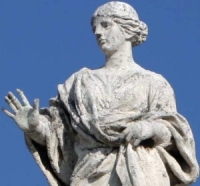
Aurelia Petronilla, Pernelle, Peroline, Perrenotte, Perrette, Perrine, Perronelle, Petronella, Peyronne, Peyronnelle, Pierrette, Pérette, Périne, Pétronille
For centuries legend said she was the daughter of Saint Peter, and that she was so beautiful that he had locked her in a tower to keep her from eligible men, but none of that is true. She may have been related to Peter, a servant, a co-worker, one of his converts, his "spiritual daughter", or the tradition may have started because of the similarities of the names. May have been related to Saint Flavia Domitilla of Terracina. Cured of palsy by Saint Peter. One story says she refused a marriage offer by a pagan king named Flaccus; when he pressed his case, she went on a hunger strike, and died three days later. Old inscriptions, however, list her as a martyr in the more common murdered-for-the-faith form.
1st century Roman citizen
• 1st century
• relics in Saint Peter's cathedral, Rome, Italy
• against fever
• dauphins of France
• mountain travellers
• treaties between Popes and Frankish emperors
• being healed by Saint Peter the Apostle
• early Christian maiden with a broom
• lying dead but incorrupt in her coffin with flowers in her hair as the coffin is opened during renovations
• receiving the newly dead into heaven
• set of keys
• spurning a marriage proposal, represented by a ring, being offered by a king
• standing with Saint Peter
• woman holding a set of keys
• woman with a dolphin
https://catholicsaints.info/saint-petronilla/
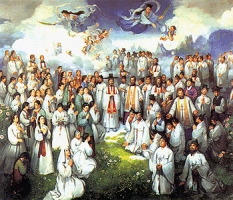
• Jacob Chu Mun-mo
• James Zhou Wen-mo
• Zhou Wenmo
20 September as one of the Martyrs of Korea
Orphaned as a child, he was raised by his grandmother. Convert to Catholicism. Studied at the diocesan seminary in Beijing, China, and was one of the first priest ordained there.
Christianity had taken root in Korea through the work of lay people who learned of the faith from books and letters written by missionaries to China. Father James was the first priest to enter the country, crossing the border on 24 December 1794. He studied Korean, and conducted his first Mass on Easter Sunday 1795. When the authorities learned of his presence, they began to hunt for him; he had been assisted in hiding out by Blessed Paulus Yun Yu-il, Blessed Matthaeus Choe In-gil, and Blessed Sabas Ji Hwang, all of whom were martyred for having helped him. Father James stayed on the move, ministering to covert Christians, compiling a catechism in Korea, organizing classes in Scripture and doctrine. Thousands were brought to the faith.
In 1801 the government began arresting and torturing lay people to learn where Father James was hiding. To stop this abuse, Father James surrendered to the authorities on 11 March 1801. Over the next 10 weeks he was repeatedly interrogated and tortured, the authorities believing he was a spy, that Christianity was subversive, that he came with some evil intent. He talked of nothing but Christ. Martyr.
1752 in Suzhou, Jiangsu, China
• beheaded on 31 May 1801 by the Han River in Saenamteo, Seoul, South Korea
• legend says that at the moment of his execution the skies clouded over and a violent hail storm descended on his executioners
15 August 2014 by Pope Francis
https://catholicsaints.info/blessed-iacobus-chu-mun-mo/
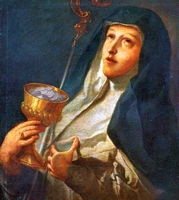
• Mechthildis of Diessen
• Mechthildis of Ammersee
• Mechthildis of Andechs
• Mechthildis von Dießen
• Mathildis, Mechtild, Mechtilde, Meta, Matilda, Matilde
Born to the nobility, the daughter of Count Berthold and Sophie of Andechs; sister of Blessed Euphemia of Altomünster. Raised in a Benedictine convent at Diessen, Germany that had been founded by her parents. When she became Benedictine nun herself, her obvious virtue led to her superiors making her novice mistress. Abbess at Driessen and then of Edelstetten Abbey in 1153 where she was known as a reformer, mystic and miracle worker.
1125 in Bavaria, Germany
• 31 May 1160 at Diessen, Bavaria, Germany of natural causes
• relics enshrined in 1468
• relics transferred to the Saint Sebastian chapel in the Diessen abbey in 1488
• relics transferred to the Saint Magdalen altar in the early 18th century
• against eye diseases
• against headaches
• against lightning
• against thunder
• being received with great celebration at the Edelstetten Abbey
• Benedictine abbess with chalice and wafers
• healing the eyes of a sister nun by a touch
https://catholicsaints.info/saint-mechtildis-of-edelstetten/
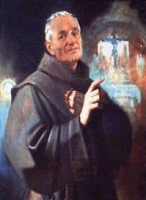
• Cicchetti (childhood nickname; means "snack size" or "little bit")
• Domenico di Nicolantonio
• Marianus...
Born to a poor but pious farm family, he worked as a shepherd on Mount Morrone until the age of 23. Joined the Franciscans in 1802 at the convent of Saint Nicholas in Arischia, Italy as a lay brother; he served as cook, gardener, woodworker and alms beggar for 12 years. Friar Minor at the Franciscan convent in Bellegra, Italy, outside Rome, in 1815. There he served over 50 years as porter, dispensing charity and aid to pilgrims and the poor. Known for great devotion to Our Lady, for his devotion to Eucharistic Adoration, and his complete poverty and disregard of worldly concerns for himself. With little education but much time in prayer, he became a spritual advisor to many.
13 January 1778 in Roccacasale, L'Aquila, Italy
31 May 1866 in Bellegra (a.k.a. Civitella), Rome, Italy of natural causes
3 May 1923 by Pope Pius XI (decree on heroic virtues)
• 3 October 1999 by Pope John Paul II
• the beatification miracle involved the complete cure of a 15 month old boy, Louis Reposini, from severe encephalitis on the evening of 28 March 1918 through the intercession of Brother Mariano
https://catholicsaints.info/blessed-mariano-of-roccacasale/
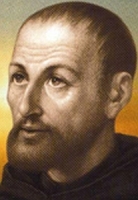
Educated by Jesuits. Joined the Minims of Saint Francis of Paola at age 19. Taught philosophy while still a deacon. Priest. Director of the library at the convent of Place Royale, Paris, France. Noted preacher. Falling ill, he was sent to the friary in Amiens, France, and then to Rouen, France. After much prayer and thought, Nicholas decided that a lack of education was behind most social evils as young people were unable to fit into society, and so he started an educational movement. Small general classes were begun in many parishes, and trade schools and apprentice programs soon developed. He helped found a community of men and women teachers dedicated to public education; these Charitable Teachers helped found several other groups with the same mission. Consulted several times by Saint John Baptist de la Salle who used Nicolas's thought when founding the Brothers of the Christian Schools. Noted spiritual director who taught an abandonment to faith. Founded Sisters of the Infant Jesus, Sisters of the Infant Jesus - Providence Sisters of Rouen, and Sisters of Providence of Lisieux.
21 October 1621 in Amiens, Somme, France
31 May 1686 in Paris, France of natural causes
7 March 1999 by Pope John Paul II
https://catholicsaints.info/blessed-nicolas-barre/
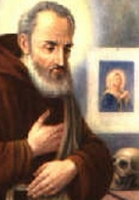
• Felice Amoroso of Nicosia
• Filippo Giacomo Amoroso
Son of a shoemaker, he learned his father's trade. Pious, hard working youth. Orphan. At age 19 he tried to enter a Capuchin convent, but was turned away; he tried again; and again; and again. After eight years of pleading, he was admitted on 19 October 1743, taking the name Felix. For 40 years he served as a beggar for his house. Had a great devotion to the Blessed Sacrament. Had the gift of healing, both physical and spiritual, and of bilocation. Worked tirelessly with the sick during a plague epidemic in Cerami, Italy in March 1777, healing many and coming though it unharmed. He was so devoted to his obedience to his Order that he asked his guardian for permission to die.
5 November 1715 in Nicosia, Italy as Giacomo Amoroso
• 31 May 1787 in Nicosia, Italy of natural causes
• relics translated to the cathedral of Nicosia in 1891
23 October 2005 by Pope Benedict XVI at Rome, Italy
https://catholicsaints.info/saint-felice-of-nicosia/
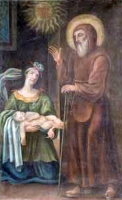
Following a wild and mis-spent youth, Vitalis had a conversion and sought to do penance first by going on pilgrimage to the most important shrines throughout Europe, and then by becoming a Benedictine monk at Monte Subasio in Umbria, Italy. Late in life he left community life to live as a barefoot hermit near Assisi, Italy; his only possession was a basket he used to fetch water. Known throughout the region for his piety and healing miracles, especially involving the urinary tract.
1295 in Bastia Umbra, Italy
31 May 1370 in Assisi, Italy of natural causes
against bladder disease
https://catholicsaints.info/blessed-vitalis-of-assisi/
• 22 November as one of the Martyrs of England, Scotland and Wales
• 29 October as one of the Martyrs of Douai
Began studying at the English College in Rheims, France on 1 March 1583. Ordained in April 1585. Returned to England on 9 May 1585 to minister to covert Catholics in Yorkshire. Betrayed to a justice of the peace by some one who had seen him preparing palm fronds, he was arrested in bed in the early morning of Palm Sunday, 1591 for the crime of being a priest. Martyr.
c.1560 in Yorkshire, England
hanged, drawn and quartered on 31 May 1591 in York, North Yorkshire, England
22 November 1987 by Pope John Paul II
https://catholicsaints.info/blessed-robert-thorpe/

• Noah Mawaggali
• Noe Mawaggali
3 June as one of the Martyrs of Uganda
Member of the Ngabi clan. Convert. One of the Martyrs of Uganda who died in the Mwangan persecutions.
at Buganda, Uganda
stabbed with a spear and torn apart by wild dogs on 31 May 1886 at Mityana, Uganda
18 October 1964 by Pope Paul VI at Rome, Italy
https://catholicsaints.info/saint-nowa-mawaggali/
22 November as one of the Martyrs of England, Scotland, and Wales
Married layman and family man in the apostolic vicariate of England who provided aid to covert priests in the persecutions of Queen Elizabeth I. Martyr.
in Menthorpe, North Yorkshire, England
hanged, drawn and quartered on 31 May 1591 in York, North Yorkshire, England
22 November 1987 by Pope John Paul II
https://catholicsaints.info/blessed-thomas-watkinson/
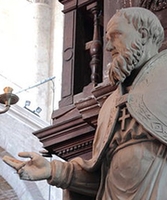 Profile
Profile
Fourth bishop of Toulouse, France. Designed and began the construction of the first basilica in the diocese. Enshrined the relics of Saint Saturninus of Toulouse.
c.400 in Toulouse, France of natural causes
https://catholicsaints.info/saint-silvio-of-toulouse/
Young layman in the diocese of Almeria Spain. Martyred in the Spanish Civil War.
2 October 1918 in Almeria Spain
31 May 1938 in Turón, Granada Spain
14 June 2016 by Pope Francis (decree of martyrdom)
https://catholicsaints.info/blessed-juan-moya-collado/
Kaspar
Premonstratensian monk. Canon of the monastery in Heylissem, Belgium. Spiritual director of the convent of Langwaden in Grevenbroich, Germany.
1544 in the Netherlands
31 May 1614 of natural causes
https://catholicsaints.info/blessed-kasper-gerarz/
Martyr.
• somewhere in the area of modern France, date unknown
• relics enshrined in modern Auvergne, France
https://catholicsaints.info/saint-alexander-of-auvergne/
Crescentianus
Martyred in the persecutions of Hadrian.
c.130 in Sassari, Sardinia, Italy
https://catholicsaints.info/saint-crescentian-of-sassari/
Camaldolese monk and priest in the abbey of Vangadizza (in modern Badia Polesine, Italy).
c.1210
https://catholicsaints.info/blessed-nicholaus-of-vangadizza/
Sixth century saint who lived in Cornwall. A church is dedicated to him, but no information about him has survived.
Ireland
https://catholicsaints.info/saint-mancus-of-cornwall/
Sixth century saint who lived in Cornwall. A church is dedicated to him, but no information about him has survived.
Ireland
https://catholicsaints.info/saint-myrbad-of-cornwall/
Sixth century saint who lived in Cornwall. A church is dedicated to him, but no information about him has survived.
Ireland
https://catholicsaints.info/saint-winnow-of-cornwall/
Martyr.
• somewhere in the area of modern France, date unknown
• relics enshrined in modern Auvergne, France
https://catholicsaints.info/saint-galla-of-auvergne/
One of the first members of the Cistercians. Monk. Abbot of the Vaucelles abbey.
c.1163
https://catholicsaints.info/blessed-nicholaus-of-vaucelles/
Professional soldier. Martyr. Mentioned prominently in Greek liturgy.
170 at Comana, Pontus
https://catholicsaints.info/saint-hermias-of-comana/
Deacon in Rome, Italy. Wrote on theology.
c.512
https://catholicsaints.info/saint-paschasius-of-rome/
Martyr.
Cirta, Numidia (in modern Algeria)
https://catholicsaints.info/saint-donatian-of-cirta/

Three young members of the imperial Roman nobility and who were raised in a palace and had Saint Protus of Aquileia as tutor and catechist. To escape the persecutions of Diocletian, the family sold their property and moved to Aquileia, Italy. However, the authorities there quickly ordered them to sacrifice to idols; they refused. Martyrs all - Cantianilla, Cantian and Cantius.
beheaded in 304 at Aquae-Gradatae (modern San-Cantiano) just outside Aquileia, Italy
https://catholicsaints.info/martyrs-of-aquileia/
Four Christians martyred together. No information about them has survived except their names - Justa, Lupus, Tertulla and Thecla.
69 on the Via Aurelia near Rome, Italy
https://catholicsaints.info/martyrs-of-the-via-aurelia/
• Martyrs of Gerunda
• Martyrs of Girona
A group of Christians martyred together. No details about them have survived but the names –
• Agapia
• Amelia
• Castula
• Cicilia
• Donatus
• Firmus
• Fortunata
• Gaullenus
• Germanus
• Honorius
• Istialus
• Justus
• Lautica
• Lupus
• Maxima
• Paulica
• Rogate
• Rogatus
• Silvanus
• Tecla
• Teleforus
• Tertula
• Tertus
• Victoria
• Victurinus
• Victurus
Gerona, Catalonia, Spain, date unknown
https://catholicsaints.info/martyrs-of-gerona/
• Mary, Mediatrix of All Graces
CatholicSaints.Info Portable Edition